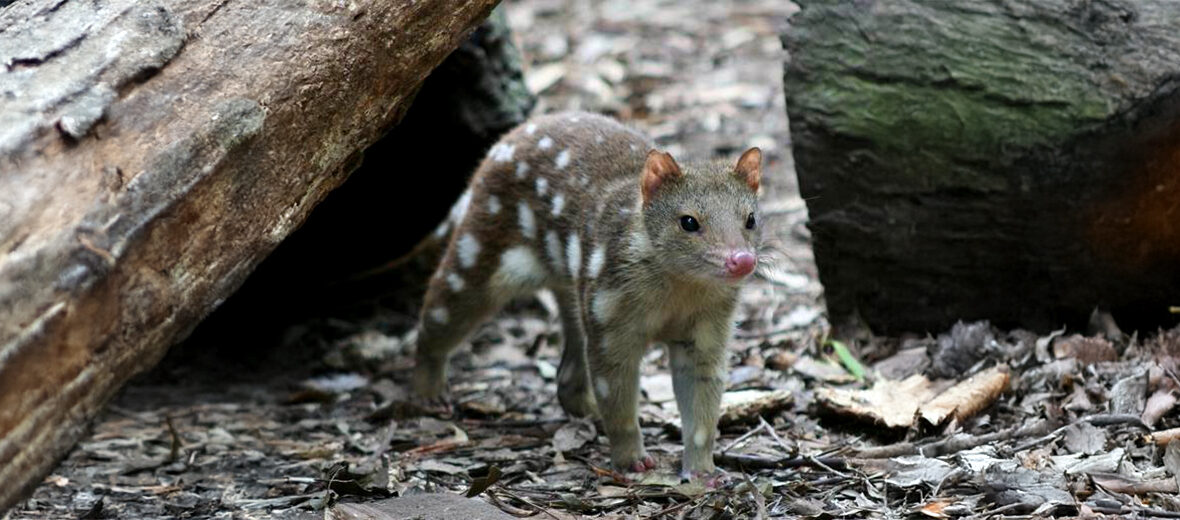
Recently rediscovered and once thought extinct, it’s the tiger quoll, aka spotted-tailed quoll, spotted quoll, spotted-tailed dasyure, or tiger cat. They can be found in eastern and southeastern Australia. These marsupials face the threats of habitat loss and destruction at the hands of the logging industry and residential & commercial developments; hunting; trapping; and invasive species, and with them disease and predation. The IUCN lists these critters as Near Threatened (within the northern subspecies) and Endangered (within the southern subspecies). Their numbers are also decreasing.
First the Stats…
Scientific name: Dasyurus maculatus
Weight: Up to 7.7 lbs.
Length: Up to 31.9 inches
Lifespan: Up to 6 years
Now on to the Facts!
1.) There were approximately 14,000 wild individuals remaining, as of 2018. That estimate is likely far less to date.
2.) Tiger quolls are the 2nd largest extant carnivorous marsupial, after the Tasmanian devil.
3.) They prey on insects, yabbies, lizards, snakes, domestic poultry, birds, various small mammals, platypuses, mice, rats, rabbits, arboreal possums, cuscuses, greater gliders, bandicoots, pademelons, smaller wallabies, and wombats. They may also scavenge larger animals like kangaroos, feral pigs, cattle, and dingoes.
4.) These quolls kill their prey via a powerful bite to the base of the skull, at the first vertebra of the neck, aka C1.
5.) Robert Kerr, the Scottish naturalist and writer, first described these quolls in 1792 and placed them in the genus Didelphis, which includes several species of American opossums.
But wait, there’s more on the tiger quoll!
6.) The species name, maculatus is Latin and translates to “spotted”, which refers to these critter’s mottled fur pattern.
7.) Quolls, in general, diversified and evolved during the late Miocene between 15 – 5 million years ago, which was a time of great diversification among marsupials.
Did you know…?
Ancestors of all current species of these critters had diverged by the early Pliocene, approximately 4 million years ago.
8.) Even though they lack a prehensile tail (a tail used as an additional appendage), these quolls still lead a mostly arboreal (spend their lives in trees) lifestyle. This is ok though, as they have well-developed halluces (toes) that help them grip branches well.
9.) Sadly, in Victoria, quoll populations have declined by nearly 50%.
10.) Even though they were considered locally extinct for 130 years, 1 was captured in the Limestone Coast in the south-east in 2023.
But wait, there’s still more on the tiger quoll!
11.) They prefer wet forest habitats like rainforests and closed eucalypt forests.
12.) These quolls pin down small prey with their forepaws and then execute a powerful and lethal bite. With large prey, they jump and latch on the back and bite the neck, thus paralyzing their prey.
Did you know…?
Quolls mark themselves via ear and mouth secretions.
13.) Tasmanian devils, masked owls, dingoes, dogs, wedge-tailed eagles, and large pythons all take their chances preying on tiger quolls.
14.) Tiger quolls are also hosts to a wide variety of species of endoparasites (internal parasites).
15.) These critters are nocturnal (active at night).
But wait, there’s still a little more on the tiger quoll!
16.) Their dens are often derived from burrows, caves, rock crevices, under houses, hollow logs, tree hollows, or under sheds.
17.) Post copulation (mating), females tend to act aggressively towards males, particularly when nearing parturition (giving birth).
Did you know…?
Among other vocalizations, coughs, hisses, guttural huffs, and piercing screams are produced as a variety of communications.
18.) Greeting each other is done via nose-to-nose sniffing. Males will also sniff the backsides of females to check for estrus (in heat).
19.) The mating behavior of tiger quolls is unique among all the quoll species in that the female will vocalize when she is in estrus and readily accepts the male’s mounting. Copulation can last as long as 24 hours!
20.) Females undergo up to a 3 week gestation (pregnancy) that yields up to 6 joeys.
But wait, there’s still a tad more on the tiger quoll!
21.) Joeys are completely blind for up to 60 days.
22.) When the joeys finally leave their mother’s marsupium (pouch) they don’t ride on her back, but rather will cling to her when frightened.
23.) At around the 100 day mark, the joeys become more independent and their mother subsequently becomes more aggressive towards her young.
24.) Conservationists are utilizing population monitoring and public education to preserve this species and plan to preserve their habitat and reduce the impacts of 1080 baiting. 1080 baiting is a method of poisoning wild animals with sodium fluoroacetate (1080), a white powder that is odorless, tasteless, and subsequently lethal.
Now a Short Tiger Quoll Video!
This video also talks about quolls in general.
Be sure to share & comment below! Also, check out the Critter Science YouTube channel. Videos added regularly!
Want to suggest a critter for me to write about? Let me know here.
Some source material acquired from: Wikipedia & IUCN
Photo credit: Joshua Cunningham




